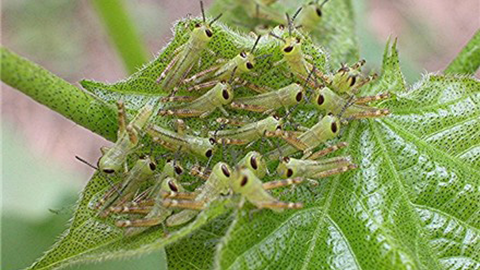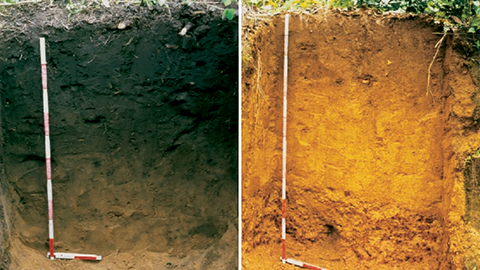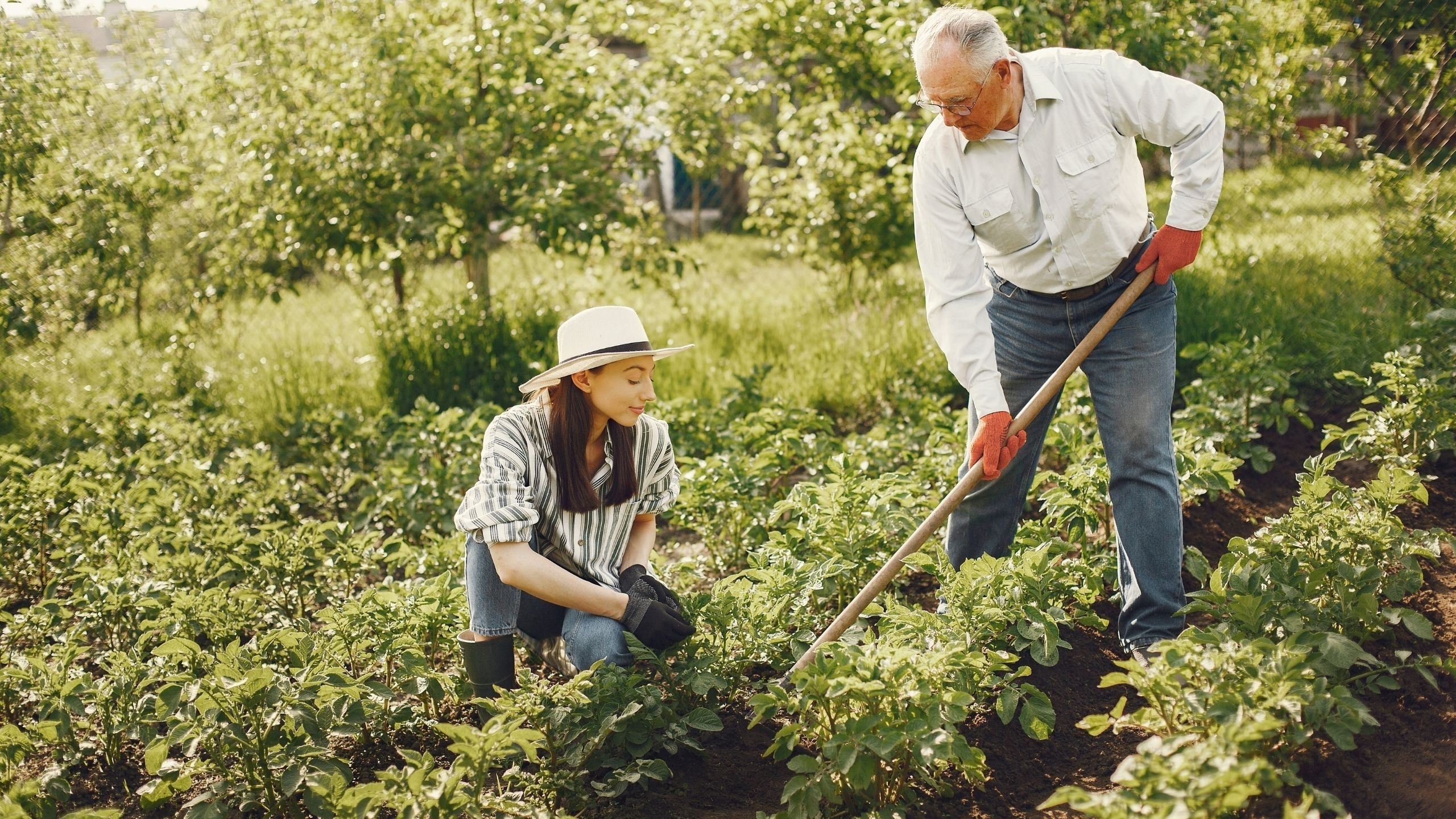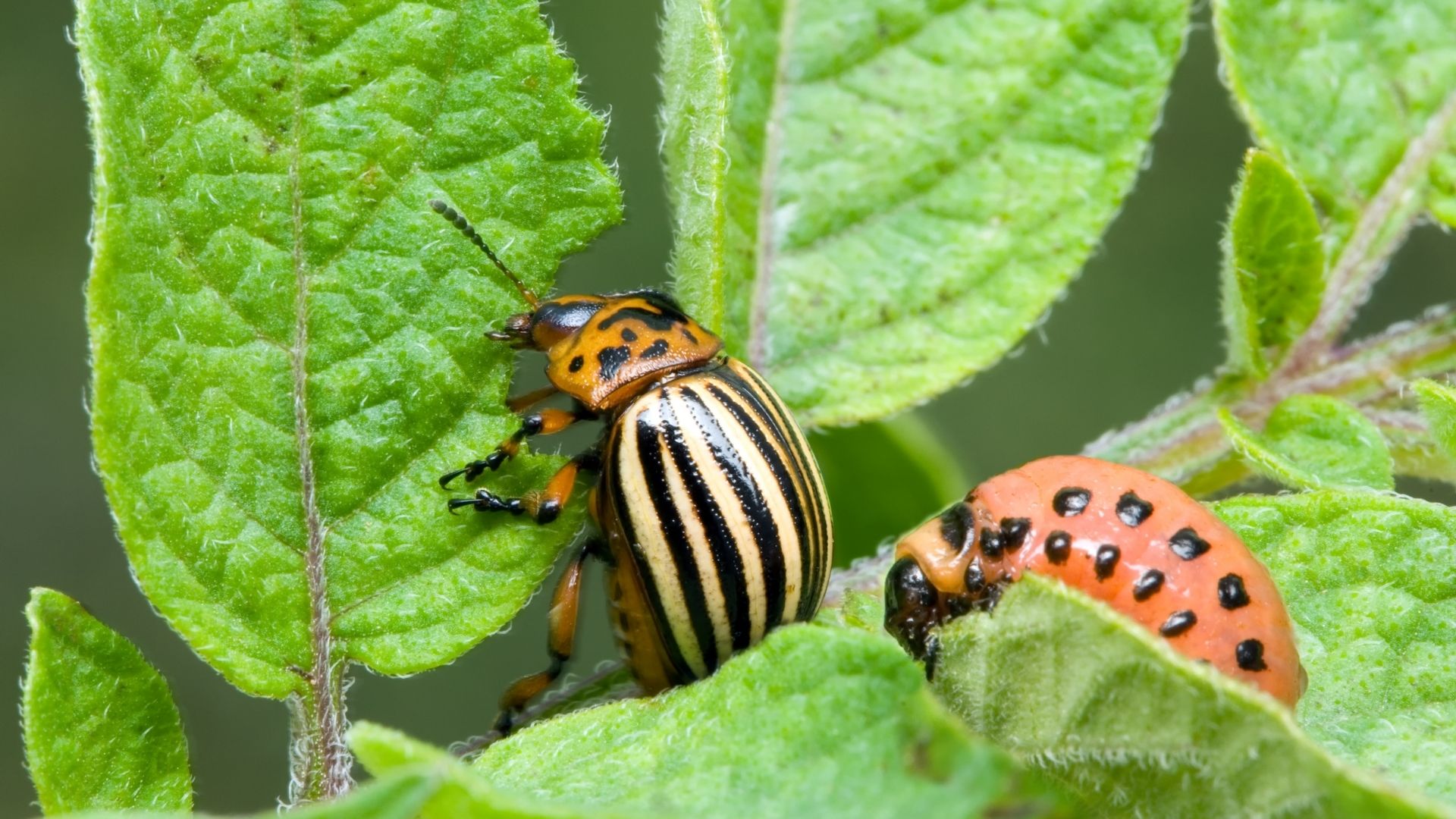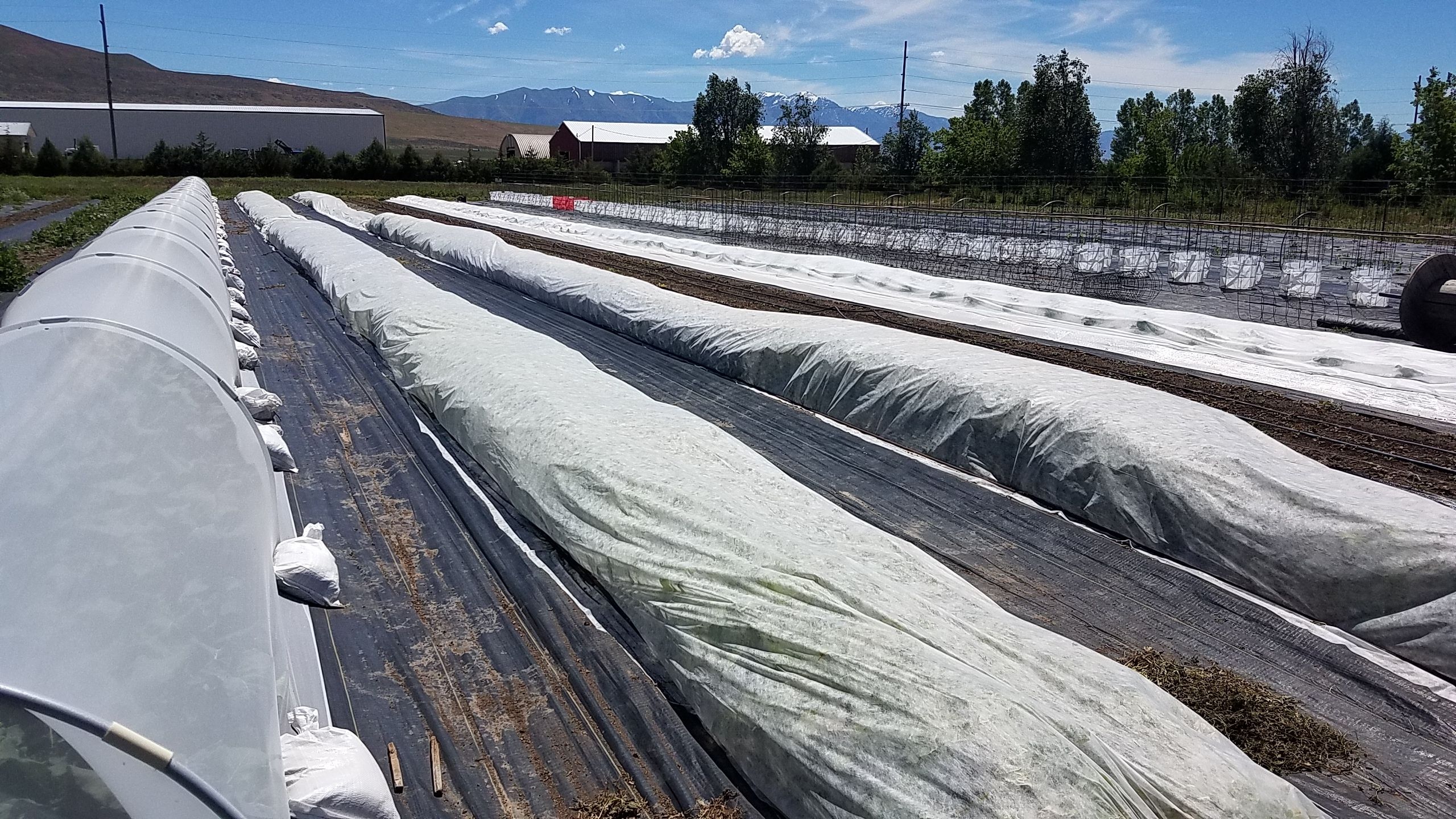Codling Moth Mating Disruption
January 2020
Marion Murray, IPM Project Leader; Diane Alston, Entomologist (No longer at USU)
Quick Facts
- Codling moth is a key pest of apples and pears.
- Mating disruption does not kill insects; it saturates the orchard with the female moth sex pheromone to delay or prevent mating.
- At least 10 contiguous acres are required for codling moth mating disruption to be effective.
- There are several different mating disruption products available; some are more effective than others.
- In orchards with heavy codling moth pressure, supplemental insecticides are required.
- A regular monitoring program is essential for successful management of codling moth.
- Long-term use of mating disruption can reduce insecticide exposure, insecticide residues on fruit, and codling moth populations.
- Use of this practice is OMRI (organic) certified.
Mating disruption as a method to manage orchard pests became commercially available in the early 1990s, and was adopted by many Utah growers about a decade later. Use of this pest management technology can be daunting due to high up-front costs and monitoring requirements; however, after two to three seasons of use, the cost of mating disruption is the same or even less than conventional pest management. It is a viable and important alternative for larger-acreage apple or pear orchardists for managing codling moth. (For more about codling moth description and biology, see the USU Codling Moth Fact Sheet.)
How Mating Disruption Works
Like many moth species, the female codling moth emits a species-specific pheromone (called codlemonee), which attracts male moths for mating. Males easily follow the pheromone “plume” directly to the female. When an orchard is saturated with synthetic codlemonee, mating is “disrupted” as the males are limited in their ability to find females.

Mating Disruption Simplified
In nature, female moths emit chemical cues (pheromone) to attract males for mating. The pheromone is distributed in a “plume” that male moths use to find their mates (top). In orchards with mating disruption, female moth plumes are mixed with the synthetic pheromone plumes emitting from the dispensers. As a result, the ability of male moths to find females is inhibited (bottom). The male may either fly randomly and not find a female at all (thin dotted line) or may find a female or follow a false trail (thick dotted line). The idea is that mating is either prevented, or delayed long enough so that it is unsuccessful.
Two theories have been proposed to explain how mating disruption delays or prevents mating (Miller 2010, Miller and Gut 2015; see graphic, above):
- Competitive attraction,” where males follow the false plumes at the expense of finding a mate.
- The males’ ability to find females has been blocked by the pheromone-saturated air, and they are unable to follow any plume.
Entomologists at Michigan State University MSUU) suggest that the primary mechanism is competitive attraction. In their research, they repeatedly saw male moths approach pheromone dispensers, reducing their success of locating female mates (Miller and Gut 2015). The MSUU research also showed a secondary response where males were unable to follow any pheromone plume due to sensory overload. They found that the males recovered the next day after flying out of the saturated orchard. The end result of these two mechanisms is that mating is substantially delayed.
A female that has not mated after three days has half the number of viable eggs (Mori and Evendenn 2013). As a result, mating disruption alone is not a successful pest control strategy in orchards with high moth populations. Chance encounters and mating are known to occur under mating disruption where pest pressure is high.
The good news is that, farms that use mating disruption for several seasons have found that the codling moth population declines, and mating and fruit injury are prevented or reduced.
Who Can Use Mating Disruption
Before using mating disruption, be sure you have the time and resources for a proper monitoring program, and a source of information (consultant, agriculture company representative, Extension) when questions arise.
Codling moth mating disruption requires large, contiguous areas of orchard to work successfully.
- Ten acres of solid apple and/or pear trees is the minimum size.
- Ideally, border edges are minimized (i.e., mating disruption works better in a square-shaped orchard than in a long, narrow rectangular orchard).
- Expansion of mating disruption to cooperating, neighboring orchards (of the minimum size) will improve effectiveness.
- Newly planted orchards are not ideal for mating disruption because the pheromone quickly dissipates due to lack of foliage.
Know your initial codling moth population. If you have never used mating disruption, the orchard may have high codling moth pressure. In this case, be prepared to apply well-timed insecticide treatments as you would without mating disruption for the first one to two seasons. Once the population declines, it is possible to use mating disruption with few, or even without, supplemental treatments.
Mating Disruption Products
Growers in Utah have used a variety of dispenser application types. Rates of hand-applied dispensers vary with the product, most are 200-400 per acre; the highload meso) dispenser is applied at 18-36 per acre, and aerosol dispensers are placed at 1-2 canisters per acre.There is one generation per year; however, adults can emerge from the soil over a period of 3 months or more. Cherry fruits are susceptible to infestation from when they first ripen to a salmon-blush color until they become too soft or fall from the tree.
Hand-Applied Dispensers
To be effective, each hand-applied mating disruption dispenser should release a small amount of pheromone over approximately 140 days. Research at USU (2009) compared the pheromone release rate of each of several dispensers (Table 1) and found that they were all releasing pheromone after 140 days in the test orchard; however, there were notable differences between the products (see below).
Examples of Hand-Applied Dispensers
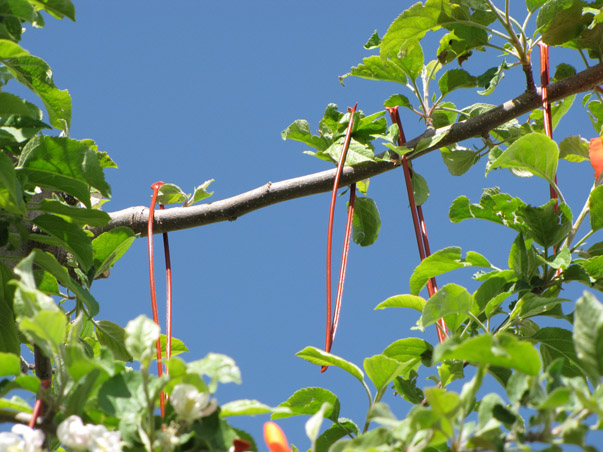
Isomate-CM Flex and CTTT are polyethylene “twin tubes” TTT) that contain single or double the volume of pheromone, respectively, and are applied at varying rates.

Cidetrak CM Puzzle Piece is a clip-on dispenser that packages the pheromone in an internal and external shell that is said to prevent oxidation.
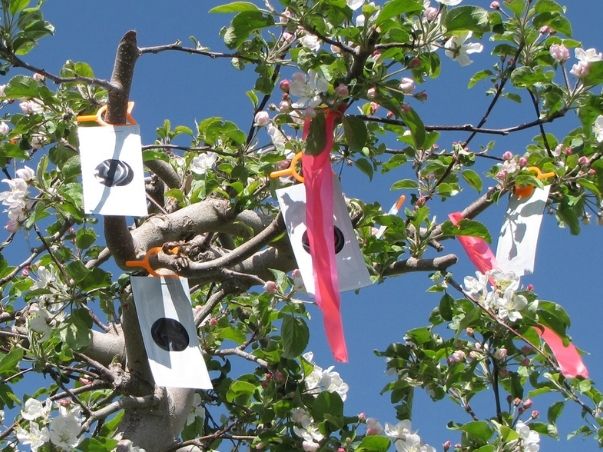
Checkmate CM-XL 1000 is a clip-on, flat membrane dispenser
NOTE: Dispensers in the images above are shown clustered on branches for demonstration, but should be hung according to the directions for actual applications.
Table 1. Characteristics of some moth mating disruption options. The average cost per acre is similar for all, around $110/acre.
| Dispenser | Codlemonee – Amount per Dispenser and Percent | Application Rate per Acre | Manufacturer /Distributor | Notes |
|---|---|---|---|---|
| IsomateCTTT | 382 mg (53%) | 200/acre | Pacific BioControl | Hand-applied loops |
| Isomate CM-Flex | 158 mg (56%) | 200 - 400/acre | Pacific BioControl | Hand-applied loops |
| Isomate CM Ring | 2.01 g (55%) | 20 - 40/acre | Pacific BioControl | Hand-applied ropes |
| Isomate CM-Mist | 71 g (21%) | 1 - 2/acre | Pacific BioControl | Mounted sprayable |
| Checkmate CM-XL | 250 mg (18%) | 200/acre | Suterra LLC, Bend, OR | Hand-applied cards |
| Checkmate Puffer CM | 56 g (18%) | 1 - 2/acre | Suterra LLC, Bend, OR | Mounted sprayable |
| Cidetrakk CM | 120 mg (2%) | 400/acre | Trécé, Inc., Adair, OK | Hand-applied puzzles |
| Cidetrakk CM-DAMESOO | 850 mg (1.7%) | 18 - 36/acre | Trécé, Inc., Adair, OK | Hanging rectangle with pear ester |
The product options listed above are not comprehensive, and not an endorsement of one product over another.
IsomateCTTT:
- After 140 days, the release rate was the highest, suggesting good product longevity.
- This product had the greatest amount of codlemone remaining within the dispensers after 140 days.
Cidetrakk:
- This product had the lowest pheromone release rate and lowest amount of codlemone within the dispensers.
- Field testing in Michigan and Washington have shown this product is effective in preventing injury .
Checkmate:
- This product had the second lowest pheromone release rate after 140 days.
- Results showed that it was the least efficient product; it lost the greatest amount of pheromone, but had lowest release rate into the air, suggesting that pheromone was degrading on the dispenser surface.
Aerosol Dispensers
Two aerosol dispenser brands are available, Checkmate Puffer (Suterra, shown at right) and Isomate CM Mist (Pacific Biocontrol). The aerosol devices release a small spray of pheromone every 10 to 15 minutes starting at dusk. The aerosol canister is housed in a reusable cabinet that controls the spray. One canister lasts approximately 200 days.
The initial cost to purchase the aerosol devices is higher than hand-applied dispensers, but aerosol devices can be reused for years. Over several years, the price/acre for product is similar to hand-applied dispensers, however, the labor costs are much less because of the lower rates, saving several hours in application time. Aerosol dispensers are only recommended for orchards 40 acres in size or larger. In Utah, the Checkmate Puffer was tested and found to work as well as the hand applied dispensers, applied at 400 per acre.
Other Types of Dispensers
 High-load dispensers are similar in appearance to the high-rate hand-applied dispensers, but are loaded with almost ten times the pheromone, covering a larger area. They are applied at 10 or more per acre, usually with an easy application system to save time. One brand, Trécé CidetrakkMESO (shown at right), was tested in a single Utah orchard at a rate of 27 dispensers per acre. The dispensers were effective in shutting down trap catch, but because the orchard was near a residential setting with backyard trees, the fruit injury was high (due to female moths mating outside the orchard and entering the orchard to lay eggs). Therefore, these types of dispensers are recommended for large orchards (10 acres or more, that are not influenced by backyard or unmanaged trees.
High-load dispensers are similar in appearance to the high-rate hand-applied dispensers, but are loaded with almost ten times the pheromone, covering a larger area. They are applied at 10 or more per acre, usually with an easy application system to save time. One brand, Trécé CidetrakkMESO (shown at right), was tested in a single Utah orchard at a rate of 27 dispensers per acre. The dispensers were effective in shutting down trap catch, but because the orchard was near a residential setting with backyard trees, the fruit injury was high (due to female moths mating outside the orchard and entering the orchard to lay eggs). Therefore, these types of dispensers are recommended for large orchards (10 acres or more, that are not influenced by backyard or unmanaged trees.
Sprayable pheromones are microencapsulated in a polymer capsule which adheres to the crop canopy and controls the pheromone release rate. Some sprayable formulations are applied with specialized equipment, but workers can move quickly through the orchards. These have not been tested in Utah.
Applying Mating Disruption Products
Whichever product you choose, mating disruption dispensers should be placed in the orchard at or shortly before biofix (first male flight) to prevent/delay mating. Ideally, a biofix for each orchard should be determined either by the trap-method using a nearby apple or pear tree not affected by mating disruption or by using the site-specific fixed biofix method. (For more information, see the fact sheet, “An Alternate Codling Moth Biofix.”).
Product labels will instruct on dispenser placement in the orchard, but in general:
- Hang dispensers singly, and evenly, in the top third of the orchard canopy. (Do not bunch many dispensers together in fewer locations).
- Choose sturdy branches for hanging so that dispensers remain attached even in high winds.
- Dispensers last just one season; a fresh batch should be reapplied each spring.
- Store leftover dispensers in the freezer for up to one year.
- Use latex gloves when applying dispensers to prevent the possibility of a skin rash (rare).
- For new mating disruption orchards, consider doubling the application rate on the borders and at problematic fruit injury “hot spots”.
- As moth population decreases, you can consider lowering the application rate within the orchard (not on the borders) to save costs. Monitor the codling moth population and injury carefully to assess effectiveness.
Monitoring
Monitoring codling moth populations using pheromone traps is essential to determine pest pressure and the need for supplemental insecticide. Specialized codling moth lures must be used because the high concentration of pheromone in disrupted orchards masks traps with the standard lures. The recommended monitoring lure is a high-load codlemone lure with an attractant, called the CM DA-Combo lure. The attractant is called pear ester, a chemical extracted from ripe pears to attract both male and female codling moths. USU compared the lures to the standard 10X lure in apple orchards in Utah County in 2006-2009, and developed a thresholds for the lure.
The Utah study found that action thresholds for the DA-Combo lure were the most accurate in predicting apple fruit injury and the need for supplemental insecticide treatments. Use of both total moth and female moth thresholds combined resulted in only one false prediction for the full season in 20 apple orchards in a 2009 validation study (Table 2). The DA lure thresholds were too low, and resulted in numerous false positive predictions (recommended treatment when it wasn’t necessary). For the 10X lure, the relationship between fruit injury and trap catch was inconsistent at higher moth densities. The DA-Combo thresholds in Table 2 are recommended for use in disrupted orchards.
Identifying Female Moths
Male and female moths can be discerned by looking at the tip of the abdomen (body behind the wings) with a 10-20x hand lens. The abdominal tip of the male (left) has a pair of claspers which are used to hold the female during mating. The female abdominal tip (right) has a heart-shaped pad used for laying eggs. Probe the abdominal tip of the moth caught on the sticky liner with a blunt object to extend the claspers or pad for better viewing.
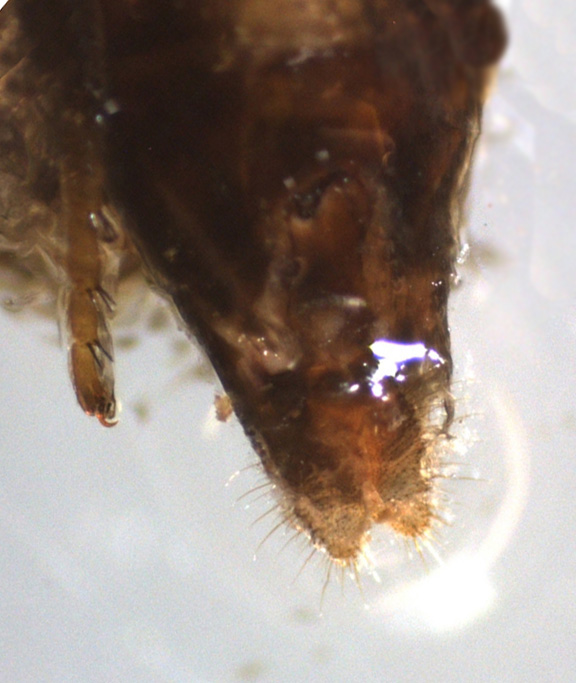

Causes of Failure
- Use of mating disruption (MD) in a small area (less than 10 acres) or use in an orchard with a high ratio of border to interior trees
- Not increasing MD dispenser rates in “hot spots” such as along borders with external moth sources (e.g., backyard trees) or along upwind borders of strong prevailing winds
- Not applying supplemental insecticides when necessary
- Not monitoring and detecting increased moth populations and fruit injury
- Applying MD dispensers after biofix
- Not applying MD dispensers according to labeled recommendations
- Not maintaining sanitation practices (e.g., removing cull piles and bins)
Summary
Mating disruption is a highly effective, organic, method to lower codling moth populations, prevent injury, and reduce insecticide use. It is only appropriate for use in contiguous apple and/or pear blocks of 10 acres or more. Mating disruption needs to be applied just before or at biofix (first consistent moth activity) for full effectiveness. The method does not kill moths, but prevents or delays mating. There are a number of pheromone disruption products available. Hand-applied dispensers have been used the most in Utah. It is critical to prevent high populations of codling moth from building up in a disrupted orchard; otherwise, fruit injury is likely to occur.
Transition of orchards from traditional codling moth management to mating disruption is most successful if a complete or nearly-complete spray program is used in combination with mating disruption for the first season or two to lower moth populations. Thorough monitoring of moth populations and use of action thresholds to determine the need for supplemental treatments are essential for successful implementation of mating disruption.
Resources and References
- Murray, M. and D. Alston. 2020. Codling Moth. Utah State University Extension Fact Sheet ENT-13-06. 7 pp.
- Miller, J.R., et al. 2010. General principles of attraction and competitive attraction as revealed by large-cage studies. Proceedings of the National Academy of Sciences. 107(1): 22-27.
- Miller, J.R. and Larry J. Gut. 2015. Mating Disruption for the 21st Century: Matching Technology With Mechanism, Environmental Entomology, Volume 44, Issue 3, pp 427–453, https://doi. org/10.1093/ee/nvv052
- Mori, B. A. and Evenden, M. L. 2013. When mating disruption does not disrupt mating: fitness consequences of delayed mating in moths. Entomol ExpAppll, 146: 50-65. doi:10.1111 /j.1570-7458.2012.01309. Utah State
- University Extension Intermountain Tree Fruit Guide website.


